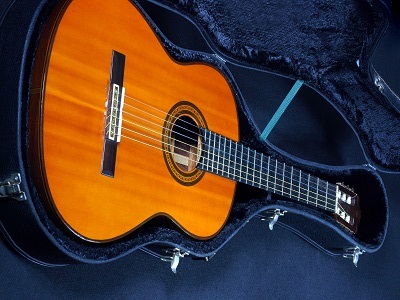Classical Guitar Lessons

Scroll down to see list of lessons…
Back in the 1800’s, the first classical guitar was created in Spain by a man called Antonio de Torres. Antonio revolutionized the entire music industry with his unique technique of using a fan strutting design in the creation of his classical guitar.
This fan strutting design allowed good sound distribution and relieved the stress caused by the strings on the body. Today, this design is still being used today by luthiers around the world.
In the past, the classical guitar was one of the popular choices of musical instruments in the world but had since seen a decline in popularity with the introduction of the acoustic guitar and electric guitar in the 1900’s. However, the classical guitar is still the choice of many for those who love classical or flamenco music.
What are the Differences Between the Various Types of Guitars?
Realize that there is a difference between playing the classical guitar as opposed to playing the acoustic guitar. The most obvious difference is that a classical guitar has a wider neck (which means that the frets are spaced further apart). This design of the guitar has the purpose of allowing players to play individual notes easily. This is the main reason why the classical guitar is seldom used in a setting where heavy strumming is required.
Different Styles And Methods of Playing
In classical guitar playing, we see guitar techniques that are used in blues, folk, and flamenco forming their roots here. Although tablatures and scales are not new to the classical guitar, most classical players play from sheet music which requires the classical guitarist to have at least some form of music theory as a pre-requisite.
On top of that, your fingernails are also an important part of playing this instrument. Since the tone and plucking of guitar strings can be affected by your nails, it is a wise idea to take good care of your fingernails if you play the classical guitar.
Online Lessons to Take You Through the Genre:
#1 – Getting Started – How to Hold the Classical Guitar
The way you hold your guitar will determine the form you take on. And trust me, it’s going to impact your playing more than you think it would.
#2 – Are There Any Ideal Methods to Proper Hand Placements?
Like the way you hold your guitar, the location of your hands will affect the way you play the instrument and perform certain techniques. Find out the recommended ways to place your hands.
#3 – Finger Picking Techniques You Can Learn And Apply Today
In this tutorial, we explore a range of finger picking techniques that are essential for all classical guitar players to be familiar with.
#4 – How to Play Staccato Notes And Sound Natural
The staccato choke can help you add emphasis to passages of music when done right. However, when done wrongly, it will sound like you made a mistake while playing your instrument.
#5 – Classical Tremolo Technique And Exercise
The tremolo technique is typically used for creating accents in certain portions of a song. Find out the correct way to play and execute the technique in this lesson.
#6 – Flamenco Guitar Basics For That Spanish Feel
Flamenco guitar is a challenging genre of music especially if you are still new to the instrument. In this introductory lesson, we show you a brief overview of playing Spanish styled music.
#7 – Flamenco Styled Guitar in Phrygian Modes
For people interested in Flamenco styled music, the Phrygian scale is one of the most important concepts you must understand and commit to your memory.
#8 – Maintaining Your Fingernails at Appropriate Lengths
Believe it or not, your fingernail is an extremely important tool to help you play the classical guitar. In this article, we discuss the ideal length that you should trim your nails to and how to take good care of them.
Learn to Play Beginner Classical Styled Guitar With Ease






Leave A Comment